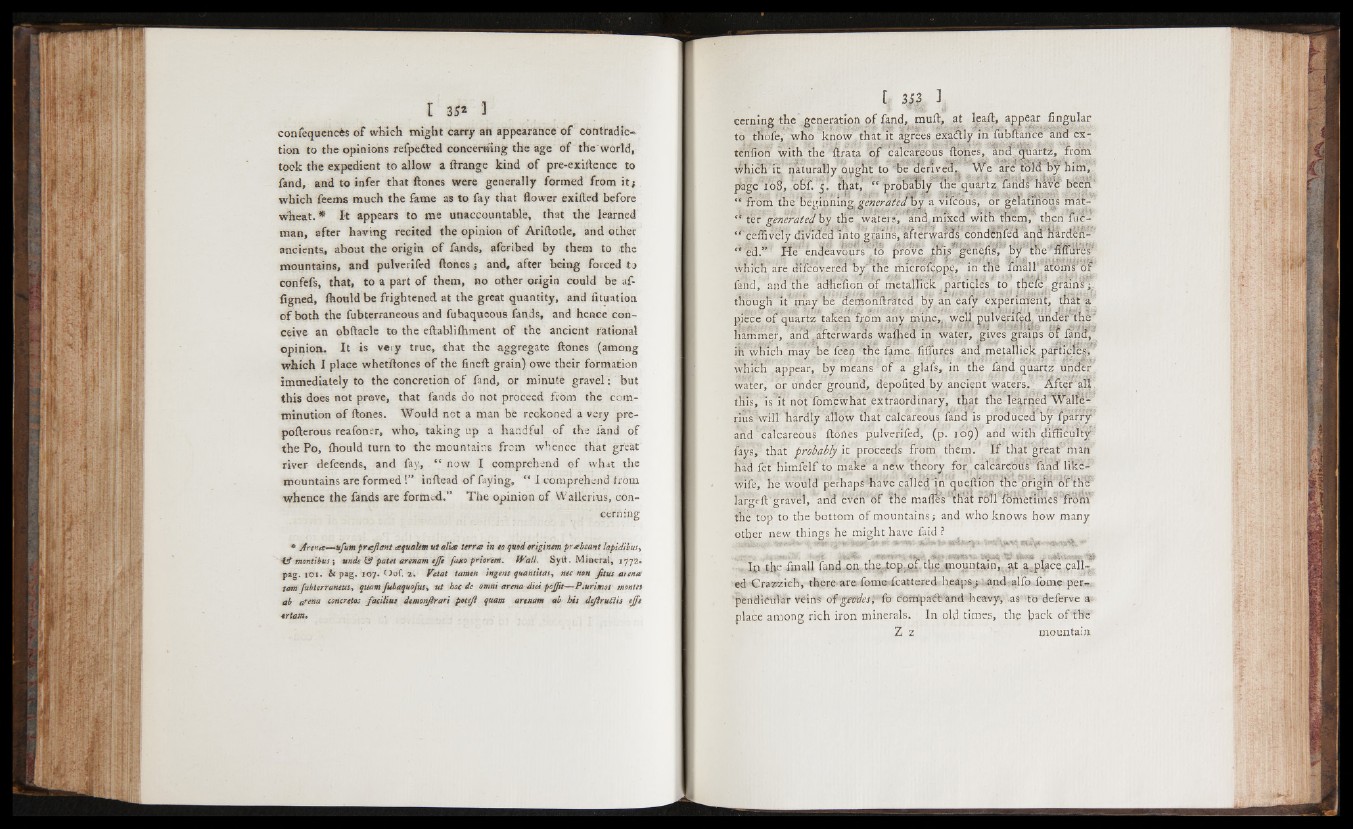
confequencès o f which might carry an appearance o f contradiction
to the opinions refpeited concerning the age o f the world,
took the expedient to allow a (frange kind o f pre-exiltence to
fand, and to infer that ftones were generally formed from it j
which feems much the fame as to fay that flower exifted before
wheat. * It appears to me unaccountable, that the learned
man, after having recited the opinion o f Ariftotle, and other
ancients, about the origin o f fands, aforibed by them to the
mountains, and pulverifed ftones ; and, after being forced to
confefs, that, to a part o f them, no other origin could be af-
iigned, fhould be frightened at the great quantity, and fituation
o f both the fubterraneous and fubaqueous fands, and hence conceive
an obftacle to the eftabliftiment o f the ancient rational
opinion. It is very true, that the aggregate ftones (among
which I place whetftones o f the fineft grain) owe their formation
immediately to the concretion o f fand, or minute gravel : but
this does not preve, that fands do not proceed from the comminution
o f ftones. Would net a man be reckoned a very pre-
pofterous reafóner, who, taking up a handful o f the fand of
the Po, (hould turn to the mountains from whence that great
river defcends, and fay, “ now I comprehend o f what the
mountains are formed !” inftead o f faying, “ I comprehend (rom
whence the fands are formed.” The opinion o f Wallerius, concerning
* Arena— ufum prajlantaqualem ut alia terra in to quod originem prabeant Ìapi dìb us>
iA monti bus-, unde IA patet arenam effe fateo priortnt. Wall. Syft. Mineral, 1772«
pag. 101. & pag. 107. Obf. 2. Vet at tamen ingens quantità s, nec non Jitus arena
tam fubierraneus, qmm fubaquofus, ut hoc de omni arena dici pojfit— Plurimo* montes
ab arena concretos facili us demonjprari poteji quam arenata ab his defiruftis eft
ortatn.
cerning the generation o f fand, muil, at leali, appear fingiilar
to thofe, who know that it agrees exailly i n fubftance and éx-
té'nfion with the ilrata o f calcareous fto'nes, ana quartz, from
which it naturally oyght to 'he derived. We are Tola'b^ him,.'
patìe4io | , "ohf. 5. flftial* v* prpfauly ffip.quartz^n'hThwd' been'
“ froth thé?B«pìining. gòteràìyabi àvncoiis, òr gèlatmbùs mat- '
“ {èv*¿entrate*} oy thè ! waters, aw n i g l l witn ffitni, then ìiic-
“ "céflively divlàéd *ntó gtami^tèii^àras. cohdIhÌe5 anà ntrdlifF’
" ed.” fie* ènaéavqurs to prove this .jjetièlìs, By* tne’!,fi1ffdlef!
which arè aìfdoyerèd’hyTthe microicope, in tne Tmàll^atòms ò f
fand, and’thè abhenon o f métaluck. particles to', thélé grains;,
though it may bé ’deiponftritéd by an eafy 'experiment, tbit a
piece1 o f quartz tahep from any mipe,, weU. ptilverued under the'
hammer, and' afterwards waìjieà in water, givés graips of fan8y
ii/winch mày’WÌeSp rthe pme„ fiifures ana^metauiclc pimcfeJP
which appear, by means o f a glafs, in the find, quartz under',
water, ór under ground, idepofited by ancient waters., After'au
this, is’ it nòffomewhat extraordinary, that the learned walfe-
rius^will hardly allow that calcareous land is produced by fparry
and calcareous ftóiies pulverifed, (p. 109) and wi'th difficulty
fays, that probably it proceeds from them. I f that great man
had fet himfelf to make' a new theory forj cal’caréóus Yaiid lik'è-
wifc, he wohld perhaps *ha^e called'in queilion thè origin' o f the
largeil'gravel, and e^en'bf Ìhe mailes^fhat fòli Ì8ih'è5 iheli’f isàm
the top to the bottom o f mountains ; and who knows how many
other new things he ixiight have (aid ?
, Ijpi the XimU fa^4-AAvth%Ì0Pv6t t^fio^ n ta in^ ^ t .^¿pl^ce £all^
ed “Crazzich, there are«fome fcattered heaps^. ;pnd<alfp»fome per-
pendièùlàr veins df 'gievdesp fo èoitìpaéb'and heavy,^as' to deferve a
place among rich iron minerals. In old times, the back o f the
Z z mountain